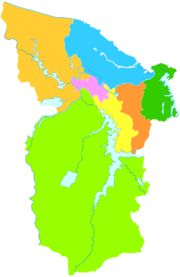Bagongshan
The Bagongshan District ( Chinese 八 公 山区 , Pinyin Bāgōngshān qū ) is a district of the prefecture-level city of Huainan in the Chinese province of Anhui . The administrative area of the city district has an area of 93 km² and has around 170,000 inhabitants (2004).
geography
The Huai He flows on the northeast border of Bagongshan , a small section of an island in this river also belongs to the municipality. The eastern part of Bagongshan lies in the alluvial plain of the Huai He, the western part is the Bagong Shan Mountains (八 八 山). The 800 million year old fossils of the so-called Huainan worm , one of the oldest multicellular organisms, were found there.
economy
Bagongshan is located in the Huainan coal field, the coal field extends in the alluvial plain north-east of the Bagong Shan Mountains. 4 million tons are accessible in the city district, the coal is mined in three pit fields.
Many mineral springs with different water qualities arise from the karst rocks of the Bagong Shan. There has been a mineral water factory in Shanwang since 1989 , which fills 2000 tons of beverages containing mineral water every year.
Culture
Liu An wrote the Huainanzi in Bagong Shan during the Western Han Dynasty . According to legend, the tofu production was invented by Liu An and his courtly sages while searching for immortality in Bagong Shan; it is also described in Huainanzi. Today "Bagongshan Tofu" is a specialty, there are dozen tofu products and more than 30 different types of preparation related to Bagong Shan.
Bagongshan is famous for its stone carving, called Zijin (紫金), which was developed at the time of the Northern Song Dynasty . Zijin stones are colored (purple, yellow, green, black, red or blue) with medium hardness and clear texture, the carvings are soft and detailed, and the motifs are diverse, depicting landscapes, portraits, animal shapes or mythical figures.
Administrative structure
At the community level, the district is made up of three street districts and two large communities. These are:
- Xinzhuangzi Street (新 庄 孜 街道)
- Tubazi Street District (土坝 孜 街道)
- Road quarter Bijiagang (毕家岗街道)
- Greater community Bagongshan District (八公山镇)
- Greater community Shanwang (山王镇)
Web links
- Official Website (Chinese)
- Info page
Individual evidence
- ↑ Bagongshan Official Website - Natural Resources: Coal . Retrieved October 9, 2019.
- ↑ Bagongshan Official Website - Mineral Resources: Mineral Water . Retrieved October 9, 2019.
- ↑ Bagongshan Official Website - History and Culture: Tofu . Retrieved October 9, 2019.
- ↑ Bagongshan Official Website - History and Culture: Zijin . Retrieved October 9, 2019.
Coordinates: 32 ° 38 ' N , 116 ° 50' E
